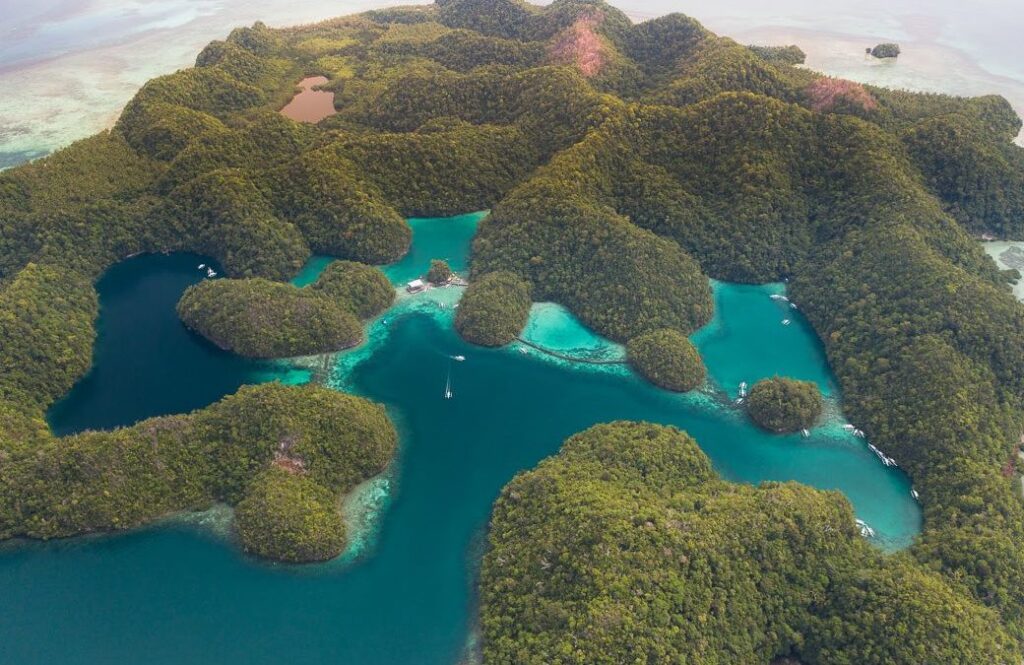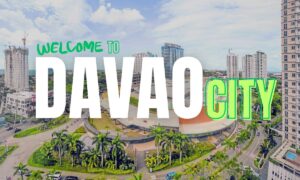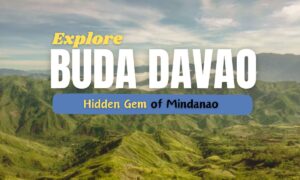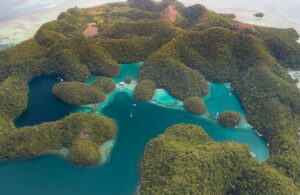The Philippines’ second-largest island, boasts a vibrant cultural mosaic with diverse ethnic groups like the Maranao and Lumad. Known for its religious diversity, the island grappled with periodic conflicts, notably the Moro struggle for autonomy. Despite these challenges, Mindanao tourist spots are a compelling destination with captivating natural wonders.
The region thrives with a diverse economy, rich natural resources, and stunning landscapes, including must-visit tourist spots like Mount Apo and the Tubbataha Reefs. Language diversity, historical significance, and ongoing peace efforts contribute to the island’s complex narrative. As a pivotal region in Philippine history, Mindanao continues to shape the nation’s cultural, economic, and social dynamics.
Mindanao: The Second-Largest Island in the Philippines
Mindanao unfolds as a captivating realm of diverse cultures and natural wonders. Home to ethnic groups like the Maranao and Lumad, the island weaves a rich cultural fabric, contributing to its unique identity. Celebrated for its religious diversity, Mindanao embraces a mosaic of traditions and practices. The island thrives with a varied economy driven by agriculture, mining, and trade, while its lush landscapes showcase treasures like the towering Mount Apo and the pristine Tubbataha Reefs. Mindanao’s historical significance, linguistic diversity, and ongoing efforts for peace collectively shape its narrative, underscoring the island’s pivotal role in influencing the cultural and economic dynamics of the Philippines.
Understanding Mindanao
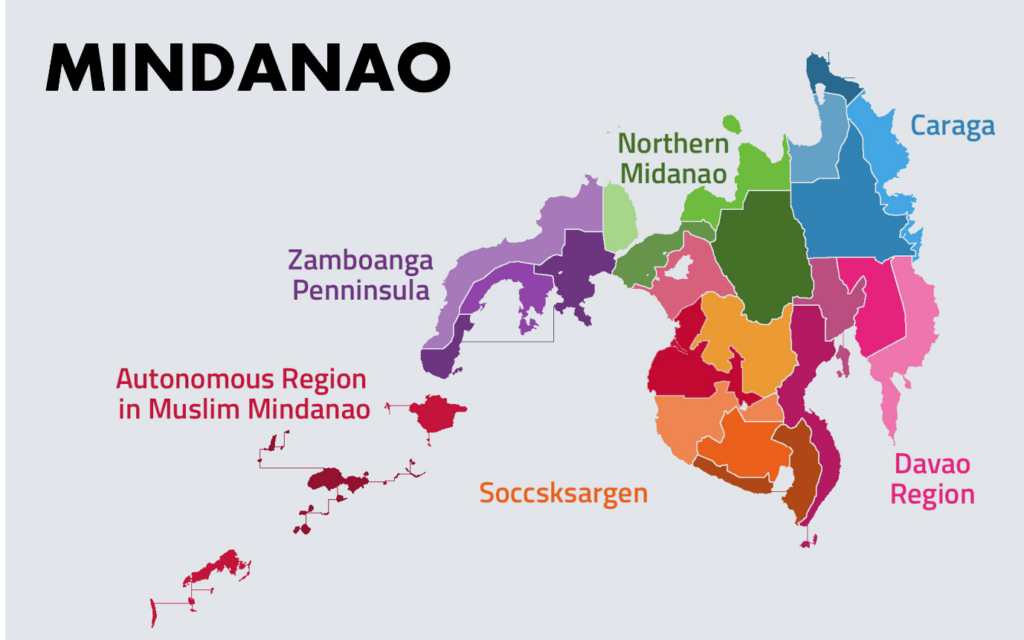
Geography
Mindanao is a geographical marvel that unfolds with diverse landscapes and natural wonders with a total area of 97,530 km². Bounded by the Celebes Sea to the south, the Philippine Sea to the east, and the Sulu Sea to the west, Mindanao boasts a strategic and picturesque coastal position. The island’s topography is a mesmerizing blend of towering mountains, fertile plains, and lush forests. The crown jewel, Mount Apo, stands proudly as the highest peak in the Philippines, offering a breathtaking panorama. Rivers and lakes crisscross the terrain, contributing to the region’s agricultural abundance. This geographical diversity and tropical climate make Mindanao a captivating destination with scenic beauty and ecological richness.
Climate
Mindanao, the Philippines’ southern gem, experiences a tropical climate with distinct wet and dry seasons. The region enjoys a relatively stable temperature throughout the year, averaging 25 to 32 degrees Celsius (77 to 89.6 degrees Fahrenheit). The dry season typically spans from November to April, bringing sunny days and warm temperatures. Meanwhile, the wet season, extending from May to October, sees increased rainfall, fostering the island’s lush vegetation and contributing to its agricultural productivity. The diverse geography of Mindanao, from coastal areas to mountainous terrain, influences microclimates, adding to the region’s climatic variety. The tropical climate defines Mindanao’s lush landscapes and affects its cultural practices and economic activities.
Demographics
Mindanao is a melting pot of diverse demographics, adding to the region’s cultural richness. Home to various ethnic groups such as the Maranao, Lumad, and more, Mindanao’s population is characterized by a tapestry of traditions and languages. The island accommodates a mix of religions, with a notable Muslim population in certain areas. Urban centers like Davao City contribute to demographic diversity, fostering economic activities and cultural exchange. Additionally, Mindanao’s demographic landscape reflects a blend of rural and urban lifestyles influenced by the island’s agricultural prominence. Understanding the demographics of Mindanao is vital to appreciating the cultural nuances and societal dynamics that shape this vibrant region of the Philippines.
The Culture of Mindanao
The culture of Mindanao is a captivating tapestry woven with the threads of diverse ethnic groups, each contributing to the region’s unique identity. Home to communities like Maranao, Lumad, and more, Mindanao embraces a rich blend of traditions, dances, and indigenous art forms. The island’s cultural landscape is adorned with vibrant festivals, reflecting the deep-rooted spirituality and communal bonds. Mindanao’s cuisine, influenced by its diverse population, introduces a variety of flavors and culinary delights. Mindanao’s traditional music and crafts further illustrate its people’s craftsmanship and artistic prowess. Mindanao invites exploring and celebrating its heritage as a dynamic cultural hub, fostering a deep appreciation for this remarkable region’s multifaceted cultural mosaic.
Festivals and Traditions of Mindanao
Mindanao’s festivals and traditions showcase the island’s vibrant cultural tapestry. Celebrations like the Kadayawan Festival in Davao City highlight indigenous rituals, dance, and agricultural abundance. The T’nalak Festival in South Cotabato pays homage to the T’boli tribe’s intricate weaving traditions. Meanwhile, the Pintados-Kasadyaan Festival in Tacloban features body painting and dance, preserving ancient Visayan customs. These festivities offer a kaleidoscope of colors, music, and rituals, providing a unique insight into Mindanao’s diverse cultural heritage. The island’s rich tapestry of festivals and traditions reflects its people’s dynamic spirit and communal pride.
The Economy of Mindanao
Mindanao’s economy is a dynamic force driven by diverse sectors. Agriculture, focusing on rice, corn, and coconut production, forms a cornerstone. The region also contributes significantly to the country’s mining and forestry industries. Urban centers like Davao City bolster trade and commerce, enhancing economic vitality. Mindanao’s vast natural resources, from minerals to marine products, contribute to its financial resilience. Ongoing infrastructure development projects further stimulate growth. Despite occasional challenges, the island’s multifaceted economy shapes the Philippines’ economic landscape, showcasing a balance between traditional industries and emerging opportunities.
How Mindanao Contributes to the Philippine Economy
Mindanao is pivotal in bolstering the Philippine economy through its multifaceted contributions. The island’s prosperous agricultural sector, producing staples like rice, corn, and coconuts, significantly influences the nation’s food security. Natural resources, including minerals and marine products, contribute to the Philippines’ economic wealth.
Mindanao’s strategic location and thriving urban centers, such as Davao City, stimulate regional trade and commerce, fostering economic growth. The island’s diverse economic landscape, encompassing agriculture, mining, and business, reflects a crucial balance that elevates Mindanao as a critical player in shaping and sustaining the broader economic dynamics of the Philippines.
Mindanao Tourist Spots: A Must-Visit Destination
Mindanao, a treasure trove of natural wonders and cultural gems, beckons travelers with an array of must-visit tourist spots. Towering above all is Mount Apo, the highest peak in the Philippines, offering exhilarating hikes and panoramic views. The Tubbataha Reefs Natural Park enchants divers with its vibrant marine biodiversity, while the captivating Enchanted River in Surigao del Sur promises a magical aquatic experience. Siargao Island, famed for Cloud 9’s surf break, invites beach enthusiasts and surfers alike. Meanwhile, the rich cultural tapestry unfolds in Davao City, home to the iconic Philippine Eagle Center and the vibrant Kadayawan Festival. Mindanao’s tourist spots promise an unforgettable journey through natural wonders and cultural marvels.
Siargao Island
Siargao, the Surfing Capital of the Philippines, is an idyllic island paradise with enchanting tourist attractions. At the heart of its allure is Cloud 9, a world-renowned surf break, drawing surf enthusiasts from around the globe. The island’s pristine white-sand beaches, such as Magpupungko and Naked Island, offer a tranquil escape. The captivating Sugba Lagoon, surrounded by mangroves and turquoise waters, invites exploration and relaxation. Siargao’s vibrant nightlife in General Luna and the lively local markets provide a taste of the island’s cultural vibrancy. With its natural beauty and dynamic activities, Siargao Island promises an unforgettable tropical experience.
Buda Davao
You can also visit Buda Davao, also known as Bukidnon-Davao Road, nestled in the highlands of Mindanao, unveiling a scenic journey replete with captivating tourist attractions. As travelers traverse this picturesque route, they encounter the breathtaking beauty of the Overview Nature and Culture Park, offering panoramic views of lush landscapes and mountains—the Ma. Cristina Ancestral House, a heritage site, provides a glimpse into local history and culture. Amidst the journey, Alalum Falls beckons with its cascading waters, inviting a refreshing stop. The cool climate of Buda Davao also enhances the charm of roadside cafes, providing a perfect setting for relaxation. This scenic route promises a delightful exploration of nature, culture, and tranquility.
Samal Island
Samal Island, nestled in the Davao Gulf, is a tropical haven with diverse and enchanting tourist attractions. White sand beaches like Paradise Island Park, Beach Resort, and Kaputian Beach showcase pristine shores and crystal-clear waters, perfect for sunbathing and water activities. The iconic Hagimit Falls, surrounded by lush greenery, offers a refreshing retreat. Adventure seekers can explore the Monfort Bat Sanctuary, home to one of the world’s largest colonies of fruit bats. Talikud Island, known for its vibrant coral reefs, entices snorkelers and divers. Samal’s cultural charm unfolds in the Moncado White House, a historical landmark. With its natural wonders and cultural gems, Samal Island and Samal Island Resorts promise a delightful escape.
Bukidnon
Bukidnon, a province in the heart of Mindanao, beckons travelers with its breathtaking landscapes and diverse tourist attractions. Nestled amidst rolling hills and lush greenery, Dahilayan Adventure Park is a thrill-seeker’s paradise, offering zip-lining and other adrenaline-pumping activities. The sprawling Monastery of Transfiguration showcases stunning architecture and panoramic views of the surrounding mountains. Nature lovers can explore Kaamulan Park, where the indigenous culture of various tribes is celebrated through vibrant festivals. Mt. Kitanglad Range Natural Park, a UNESCO World Heritage Site, entices hikers with its challenging trails and rich biodiversity. With its mix of adventure, culture, and natural beauty, Bukidnon offers a captivating escape for all kinds of travelers.
Is Mindanao Safe?
Yes, Mindanao is one of the safest regions in the Philippines. Mindanao became one of the safest regions after the sitting of the former President. Rodrigo Durterte. He prioritized the safety of the people of the Philippines, especially Mindanao, a region where he lives. While Mindanao, like any other destination, has faced periodic security challenges, it is essential to recognize that safety conditions can vary across different areas.
Mindanao’s safety and security concerns are paramount for those traveling to this region. Certain regions have experienced historical tensions, including the sporadic conflict related to autonomy struggles. However, many places in Mindanao are peaceful and welcoming to visitors. That is Mindanao culture. Travelers must stay informed about the current situation, follow travel advisories, and consider local insights when planning their visit. Tourism has steadily grown in safer regions, showcasing the positive aspects of Mindanao’s cultural richness and natural beauty.
Conclusion
In conclusion, Mindanao stands as a captivating region, blending rich cultural diversity, natural beauty, and unique attractions. Despite historical challenges, the island continues to shape the Philippines’ cultural, economic, and social dynamics. Mindanao’s vibrant tapestry, including diverse ethnic groups and festivals, embodies the essence of Mindanao culture. Tourist spots like Mount Apo, Tubbataha Reefs, and Siargao showcase the region’s allure. The economic contributions, climatic nuances, and demographic diversity further underscore Mindanao’s significance. Travelers exploring Mindanao can embrace its cultural heritage, enjoy scenic landscapes, and contribute to the local economy. While safety considerations exist, staying informed and choosing destinations wisely enable a rewarding experience in this multifaceted and evolving part of the Philippines.

